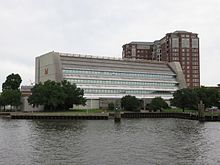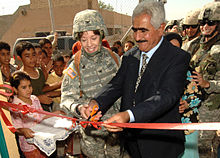
Back فيلق القوات البرية الأمريكي الهندسي Arabic Cos d'Enginyers de l'Exèrcit dels Estats Units Catalan United States Army Corps of Engineers Danish United States Army Corps of Engineers German Cuerpo de Ingenieros del Ejército de los Estados Unidos Spanish سپاه مهندسی ارتش ایالات متحده Persian Corps du génie de l'armée des États-Unis French United States Army Corps of Engineers Frisian חיל ההנדסה של צבא ארצות הברית HE Korps Zeni Angkatan Darat Amerika Serikat ID
This article needs additional citations for verification. (February 2022) |
| United States Army Corps of Engineers | |
|---|---|
 USACE Shoulder Sleeve Insignia | |
| Active | 1775–present |
| Country | |
| Branch | |
| Type | Direct Reporting Unit |
| Role | Military engineering |
| Size | Corps |
| Part of | |
| Headquarters | Washington, D.C., U.S. |
| Motto(s) | French: Essayons, lit. 'Let Us Try' |
| Colors | Scarlet and white |
| Anniversaries | 16 June (Organization Day) |
| Wars | |
| Website | U.S. Army Corps of Engineers |
| Commanders | |
| Commander and Chief of Engineers | Lieutenant General Scott A. Spellmon |
| Deputy Commander | Major General William H. Graham Jr. |
| Insignia | |
| Flag |  |
| Logo |  |
| Coat of arms |  |
| Engineer Regimental insignia |  |
| Abbreviation | USACE |






The United States Army Corps of Engineers (USACE) is both a direct reporting unit (DRU) and the military engineering branch of the United States Army that has three primary mission areas: Engineer Regiment, military construction, and civil works. USACE has 37,000 civilian and military personnel,[2] making it one of the world's largest public engineering, design, and construction management agencies. The USACE workforce is approximately 97% civilian, 3% active duty military. The civilian workforce is primarily located in the United States, Europe and in select Middle East office locations. Civilians do not function as active duty military and are not required to be in active war and combat zones, however volunteer (with pay) opportunities do exist for civilians to do so.
The day-to-day activities of the three mission areas are administered by a lieutenant general known as the chief of engineers/commanding general. The chief of engineers commands the Engineer Regiment, comprising combat engineer, rescue, construction, dive, and other specialty units, and answers directly to the Chief of Staff of the Army. Combat engineers, sometimes called sappers, form an integral part of the Army's combined arms team and are found in all Army service components: Regular Army, National Guard, and Army Reserve. Their duties are to breach obstacles; construct fighting positions, fixed/floating bridges, and obstacles and defensive positions; place and detonate explosives; conduct route clearance operations; emplace and detect landmines; and fight as provisional infantry when required. For the military construction mission, the chief of engineers is directed and supervised by the Assistant Secretary of the Army for installations, environment, and energy, whom the President appoints and the Senate confirms. Military construction relates to construction on military bases and worldwide installations.
On 16 June 1775, the Continental Congress, gathered in Philadelphia, granted authority for the creation of a "Chief Engineer for the Army". Congress authorized a corps of engineers for the United States on 11 March 1779. The Corps as it is known today came into being on 16 March 1802, when the president was authorized to "organize and establish a Corps of Engineers ... that the said Corps ... shall be stationed at West Point in the State of New York and shall constitute a Military Academy." A Corps of Topographical Engineers, authorized on 4 July 1838, merged with the Corps of Engineers in March 1863.
Civil works are managed and supervised by the Assistant Secretary of the Army. Army civil works include three U.S. Congress-authorized business lines: navigation, flood and storm damage protection, and aquatic ecosystem restoration. Civil works is also tasked with administering the Clean Water Act Section 404 program, including recreation, hydropower, and water supply at USACE flood control reservoirs, and environmental infrastructure. The civil works staff oversee construction, operation, and maintenance of dams, canals and flood protection in the U.S., as well as a wide range of public works throughout the world.[3] Some of its dams, reservoirs, and flood control projects also serve as public outdoor recreation facilities. Its hydroelectric projects provide 24% of U.S. hydropower capacity.
The Corps of Engineers is headquartered in Washington, D.C., and has a budget of $7.8 billion (FY2021).[4]
The corps's mission is to "deliver vital public and military engineering services; partnering in peace and war to strengthen our nation's security, energize the economy and reduce risks from disasters."[5]
Its most visible civil works missions include:
- Planning, designing, building, and operating locks and dams. Other civil engineering projects include flood control, beach nourishment, and dredging for waterway navigation.
- Design and construction of flood protection systems through various federal mandates.
- Design and construction management of military facilities for the Army, Air Force, Army Reserve, and Air Force Reserve as well as other Department of Defense and federal government agencies.
- Environmental regulation and ecosystem restoration.
- ^ "Biography of Debra M. Lewis". Retrieved 8 October 2014.
- ^ "About -- Headquarters U.S. Army Corps of Engineers". usace.army.mil. Retrieved 12 January 2015.
- ^ "Headquarters U.S. Army Corps of Engineers". army.mil.
- ^ Normand, Anna E.; Carter, Nicole T. (24 March 2021). Army Corps of Engineers: FY2021 Appropriations (Report). Congressional Research Service. p. 1. Retrieved 19 July 2021.
- ^ "Mission and Vision -- Headquarters U.S. Army Corps of Engineers". army.mil.
© MMXXIII Rich X Search. We shall prevail. All rights reserved. Rich X Search